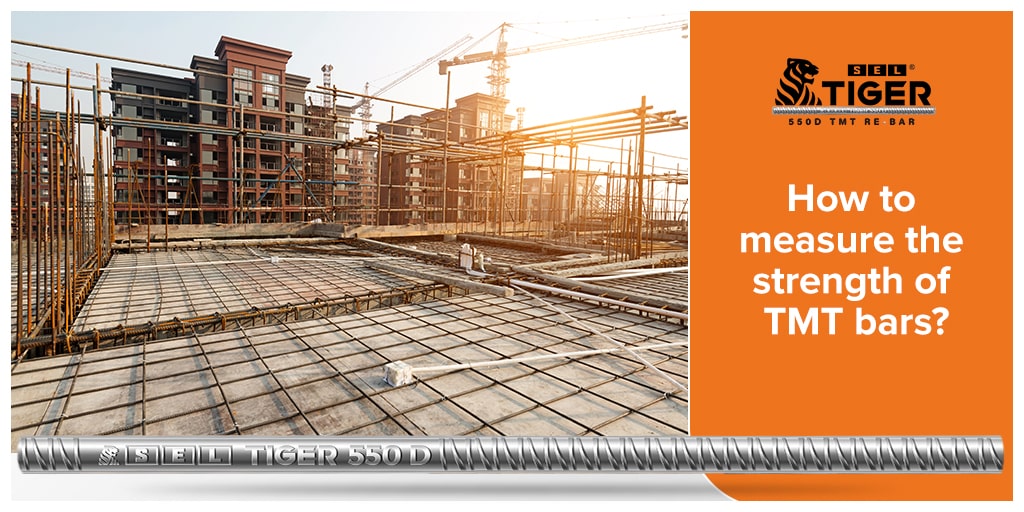
The materials used in construction projects play a significant role in determining the success and durability of the finished project. TMT bars, in particular, are known for their high tensile strength, ductility, and corrosion resistance, which makes them a popular choice among architects, construction engineers, and builders. However, before selecting TMT bars it is necessary to ensure that the bars are strong and suitable for your project. As one of the best TMT brands in India, we share with you some of the useful insights on measuring the strength of TMT bars:
The tensile strength test is one of the most common methods to measure the strength of TMT bars. The test involves preparing a sample of the TMT bar as per standards and placing it in a Universal Testing Machine (UTM) where a concentrated force is applied until the bar fractures. The maximum force applied and the actual cross-sectional area of the TMT bar are used to calculate the ultimate tensile strength (UTS). Yield strength is detected by selecting a point on the stress-strain curve where the TMT bar no longer remains elastic and becomes plastic. Both ultimate tensile strength and yield strength are crucial measurements for assessing the strength and flexibility of TMT bars.
The tensile strength of S-E-L Tiger TMT bars is measured using a universal testing machine (UTM)- it is designed to apply a controlled amount of force to a sample of the material to determine its mechanical properties, such as tensile strength, 0.2% proof stress, percentage of elongation, and total elongation. The UTM is equipped with a load cell, which measures the force applied to the sample, and a crosshead, which moves up and down to apply the force. The results obtained from the UTM can help to determine the suitability of the material for a specific application, and ensure that it meets the required standards and specifications.
Sampling & test piece preparation :
i) A sample (600 mm Approx. ) is collected from the cooling bed / lot. Sample surface should be defect free
ii) For deformed steel bar (IS 1786)/ steel round bar(IS 2062), sample is cut 0.5mtr (min)
iii) For other national or international standards, the sample is prepared as per the specification.
YS/0.2% proof stress, UTS, and elongation can be determined by following these steps:
The flexibility and bending strength of TMT bars are examined in a bending test, where the bar is subjected to a specified bending radius or diameter until it cracks or fractures. The TMT bar is bent in a device and visually inspected for fractures and cracks. The bending strength is calculated by dividing the maximum stress exerted on the bar during the bending test by the distance between the neutral axis and the outer surface of the bent bar. Higher bending strength indicates better ductility and elasticity of the TMT bar.
For S-E-L Tiger TMT bars, the bending test is conducted as per IS 1599 and using appropriately sized mandrels as specified in IS 1786.
Sampling & test piece preparation :
Procedure:
The rebend test is carried out to verify that the TMT bar has enough ductility to withstand bending and rebending without cracking or breaking. The re-bend test is important to ensure that the TMT bars meet the required standards and specifications for use in construction.
For S-E-L Tiger TMT bars, the bending test is conducted as per the guideline and appropriately sized mandrels as specified in IS 1786.
Procedure:
The specimen shall be considered to have passed the test if no rupture or cracks are visible to a person of normal or corrected vision on the rebent portion.
You might like to read: How to build a strong building foundation?
Explore S-E-L Tiger TMT bars. The size range of the S-E-L Tiger TMT Rebar is from 5.5 mm to 32 mm. We operate two state-of-the-art integrated steel plants to fulfil the modern construction demands with the best quality TMT bars. Our TMT bars are widely known for their strength, durability, and versatility across India. The perfect blend of carbon and manganese endows the bars with endurance, making them resistant to fire, corrosion, and earthquakes.